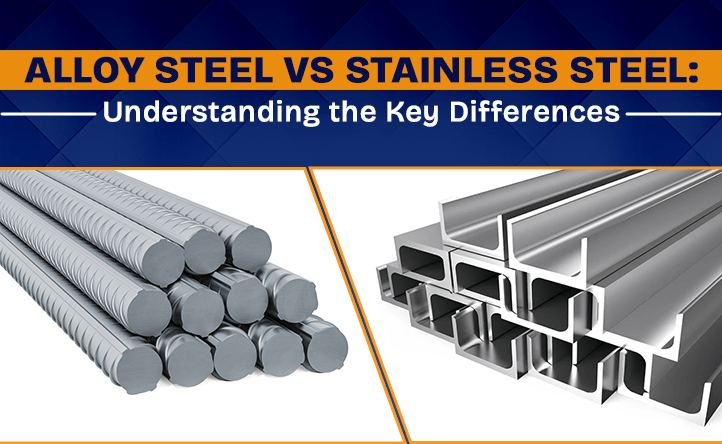Alloy Steel vs. Stainless Steel : Understanding the Key Differences Driving India’s Growth
Walk into any factory floor, a construction site, or even peek under the hood of your car, you’ll find one common hero: steel. It’s the salient backbone of India’s growth story. But here’s the thing: not all steel is created equal. Two of the most talked-about players in this space are Alloy Steel and Stainless Steel.
At first glance, they might look similar—solid, strong, built to last. But dive deeper, and their differences tell a bold, futuristic story about India’s infrastructure, precision-driven industries, and global competitiveness.
At Kinetic Industries, we’re at the heart of this transformative journey—delivering alloy steel round bars, stainless steel rods, industrial steel plates, and precision engineering components that fuel everything from highways to high-rises, from industrial components to automotive components.
So, let’s unpack the science, the strengths, and the sheer impact of Alloy Steel vs. Stainless Steel—and why this choice matters for India’s rise as a global industrial powerhouse.
1. Composition and Alloying Elements
Think of steel as a recipe. Change the ingredients, and you change the outcome.
Alloy Steel:
- This type of steel gets its edge from the addition of specific alloying elements like chromium, nickel, molybdenum, vanadium, or manganese. These aren’t random sprinkles—they’re carefully measured to enhance hardness, toughness, or wear resistance. In alloy steel round bars, for instance, chromium boosts corrosion resistance, while molybdenum fortifies strength at high temperatures.
Stainless Steel:
- The defining ingredient here is chromium—at least 10.5% content. This is what creates that iconic self-healing surface film, making stainless steel rods and plates resistant to rust, stain, and corrosion. Nickel often joins the mix to add ductility, while molybdenum sharpens defense against extreme conditions.
Bottom line? Alloy steel excels in mechanical strength and adaptability. Stainless steel, meanwhile, is your go-to when durability and aesthetics matter.
2. Key Differences in Properties
Here’s where the “steel siblings” really part ways.
-
Strength & Hardness:
Alloy steel typically outperforms stainless steel in tensile strength and wear resistance—making it the preferred choice for heavy-duty industrial parts and engineering components under high-stress conditions.
-
- Corrosion Resistance:
Stainless steel leads here, thanks to chromium’s magic shield. Imagine it as an invisible armor, self-repairing whenever scratched—critical for infrastructure solutions that face humid, coastal, or chemical-exposed environments.
- Corrosion Resistance:
-
Machinability & Welding:
Alloy steel can be tougher to machine but versatile with heat treatments. Stainless steel, despite its toughness, requires advanced handling during welding—perfectly aligning with modern precision engineering components.
-
Cost & Availability:
Stainless steel is generally higher in cost due to its high chromium and nickel content. Alloy steel, by contrast, provides a wider range of construction solutions and industrial components with cost flexibility depending on grade.
In short: Alloy steel is about rugged performance; stainless steel is about resilience and longevity.
3. Industrial Applications and Uses
Steel isn’t theory—it’s transformation in real life. Let’s see how industries across India are mobilizing these materials as the nation builds smarter, stronger, and more sustainable.
Alloy Steel Applications
-
Automotive Components:
Think gears, shafts, axles—alloy steel round bars are the silent workhorses in cars, trucks, and railways. Their strength and heat resistance are non-negotiable for safety and performance.
-
Engineering Components:
In turbines, pumps, or power plants, alloy steels provide the endurance needed for reliability.
-
Construction Solutions:
Bridges, tunnels, and structural frameworks use alloy steels for their unparalleled load-bearing capabilities.
Stainless Steel Applications
-
Infrastructure Solutions:
From railway stations to airports—where aesthetics meet strength—stainless steel rods deliver both shine and stamina.
-
Industrial Components:
Used extensively in chemical, textile, and food-processing factories where corrosion resistance is crucial.
- Engineering Services & Architecture:
Urban skylines gleam with stainless steel facades, merging design with durability.
4. How to Choose: Key Factors for Selection
So, how do industries decide between Alloy Steel Round Bars and Stainless Steel Rods? Here are the guiding lights:
- Nature of Use: If the job is mechanical endurance (shafts, bearings, heavy industrial parts), alloy steel wins. If it’s about resisting environments (water plants, chemical pipelines), stainless steel dominates.
- Environmental Exposure: High humidity, saline conditions, or chemical-heavy settings scream for stainless steel. Dry or controlled atmospheres call for alloy steel’s toughness.
- Budget Constraints: Alloy steels often fit heavy-duty projects with budget restrictions, while stainless steels are an investment in long-term resilience and reduced maintenance.
- Performance Demands: Where precision and reliability are uncompromising—say, aerospace engineering or high-precision medical devices—selection hinges on both performance properties and compliance standards.
5. Kinetic Industries – Your Trusted Supplier for Quality Steel
India’s growth isn’t abstract. It’s tangible: the new highways being paved, the bullet trains on the horizon, the factories buzzing with engineering components and industrial parts that power everything from precision engineering components to automotive & construction solutions.
This is where Kinetic Industries leads as one of India’s most reliable industrial steel suppliers. With a portfolio spanning Stainless Steel Rods, Alloy Steel Round Bars, Industrial Steel Plates, and tailor-made engineering services, we don’t just supply steel—we supply the backbone for progress.
Our clients don’t just buy materials; they invest in trust, endurance, and expertise. Every sheet, bar, or plate is more than a product—it’s a solution to scale modern India’s ambitions.
The Future is Forged in Steel
As India accelerates toward becoming a global hub for manufacturing and infrastructure, the steel debate is not just metallurgical—it’s symbolic. Alloy Steel vs. Stainless Steel isn’t about competition. It’s about harmony. Together, they give India the propulsion it needs: the brute ruggedness of alloy steel powering automotive components and heavy industry, and the sleek resilience of stainless steel building the resilient, futuristic skylines of tomorrow.
At Kinetic Industries, we believe every industrial component, engineering component, stainless steel rod, and alloy steel round bar is more than just metal. It’s a catalyst—driving India upward, forward, and stronger.
Because the future? It’s not just written. It’s engineered in steel.


